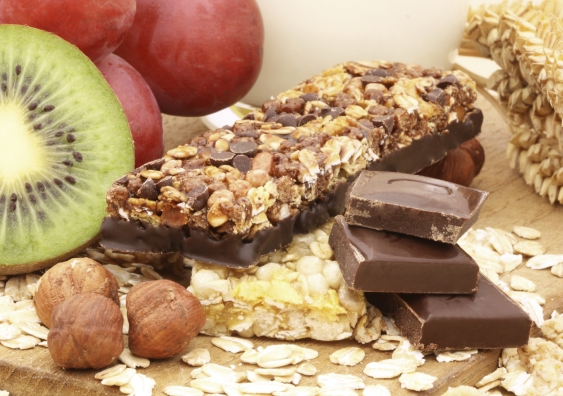Is that muesli bar you put in your child’s lunchbox actually healthy?
Think muesli bars are a healthy snack? Take another look, writes Rebecca Charlotte Reynolds.
Think muesli bars are a healthy snack? Take another look, writes Rebecca Charlotte Reynolds.

OPINION: There are rows upon rows of packaged snack foods in supermarkets, including snack bars made from muesli, cereal, nuts, seeds and fruit. Many of the labels on the packages shout out words such as “natural”, “protein”, “oaty”, “super-food”, “wholegrain”, “light”, “gluten-free” and “97% fat-free!”.
But these words can mask unhealthy products. Many processed snack bars are high in added sugar, refined starch and fat.
Knowing what is in snack bars is of particular importance to parents given nearly one in five two- to 18-year-olds consume these muesli or cereal-style bars, and one in four Australian children are overweight or obese.
So, how do you navigate the confusing snack bar terrain? Here are five tips.
Choose more products that have the following ingredients in higher quantities. Some, such as nuts and oats, should be listed as the first ingredients on the back of the packet:
grains such as oats, barley and quinoa. Even if a product boasts it is “whole grain”, this doesn’t necessarily mean it’s the best choice. Whole grain usually means higher in fibre, which is good, but can also mean high glycemic index (GI) if the grain has been overly processed.
nuts and seeds, which provide beneficial nutrients including protein, good fats, fibre, micronutrients and phytochemicals (nutrients naturally occurring in plants).
dried fruit, which provides beneficial nutrients including carbohydrate, fibre, micronutrients and phytochemicals. Just remember dried fruit sticks to teeth and can contribute to tooth decay, and some dried fruit can have added sugar, such as cranberries. Whole fruit is always better.
ingredients like “dietary fibre” (such as inulin or psyllium husk), milk powder or solids and whey/milk protein.
Choose products that contain some:
honey, my preferred choice of sweetener, which can be low GI and provides small amounts of proteins, enzymes, amino acids, minerals, trace elements, vitamins, aroma compounds and polyphenols (micronutrients that can prevent disease).
coconut flesh, which provides nutrients including fibre, micronutrients and saturated fat, which is likely healthier than the saturated fat in meat, and likely less healthy than the fat and oils in nuts, seeds, vegetable oils and fish.
I would suggest the following snack bar products over other products (including alternative products made by same brand), as they likely provide better nutrition, including being higher in fibre and lower in GI: Carman’s fruit-free muesli bar, Be Natural Deluxe Nut Bars Nut Delight and Goodness Superfoods better for U! Cranberry Nut Cereal Bars.
Choose fewer products that have higher quantities of any combination of the following ingredients:
added sugars: the list of these is endless and includes sugar, cane sugar, brown sugar (also called sucrose sugar), glucose sugar, golden syrup, malt syrup, brown rice, rice, rice malt syrup and fruit juice. (I have particular issue with things like brown rice syrup, because people mistakenly think it’s “good for you”, when in fact it is a readily digestible high GI sugar mix that provides little else than sugar. Added sugars are a real public health problem and intakes should be reduced in most people).
added fats such as butter and cream. These foods are high in saturated fat, which evidence shows can damage the cardiovascular system.
processed high GI starches such as wheat starch, wheat puffs, wheat flakes, wheat flour, rice flour, rice crisps, puffed rice, maltodextrin and maize flour (the wholegrain options are better, such as wholegrain wheat flour).
chocolate or “yoghurt compound” (which is basically chocolate), which is high in saturated fat and sugar.
salt, which is not good for your cardiovascular system in excess.
artificial colours and flavours and other additives, which you will see on most ingredient lists of processed snack foods, such as soy lethicin (see below).
This list means trying to avoid a large percentage of the muesli/cereal/nut/seed/fruit bars out there.
Food Standards Australia New Zealand provides an online list of food additives. Additives are used in processed foods to improve taste, appearance, quality, stability and storage life.
Some people think all additives are bad. Some of them are in fact natural. Vitamin C/ascorbic acid (additive number 300) can be added to foods, but is also naturally present in fruit. The human body can’t distinguish between a chemical naturally present in a food and the same chemical present as an additive.
However, some additives may cause problems such as damage to the gut, hyperactivity in children and potential cancer links. Don’t demonise all additives but do decrease processed food intake – and for more reasons than just additives.
The government’s health star food rating system has its flaws, including that it doesn’t take into account every nutritional aspect of a processed food product. However, it is useful when comparing different snack bars: if you choose one that has five stars it is likely better nutritionally than one with three stars.
This won’t be welcome news to your free time: home-made versions of processed snack foods are the best. Being able to make a muesli bar/slice that is packed with ingredients such as oats, nuts, seeds, free-range eggs and extra virgin olive oil (lightly flavoured) will provide a healthy snack for your child.
Luckily you can make one big batch that should last for a week’s worth of lunchboxes between a few kids. See here and here for more lunchbox ideas.
I don’t believe in all-or-nothing when it comes to life, including nutrition. Maybe your little one really loves the chocolate- and yoghurt-covered snack bars? Well, perhaps one of each per week in his/her lunchbox is an idea.
You don’t want to be overly restrictive with your child’s food, because this may have the opposite effect to what you intended and increase their eating and weight over time.
Rebecca Charlotte Reynolds is a Lecturer in Nutrition at UNSW.
This opinion piece was first published in The Conversation.